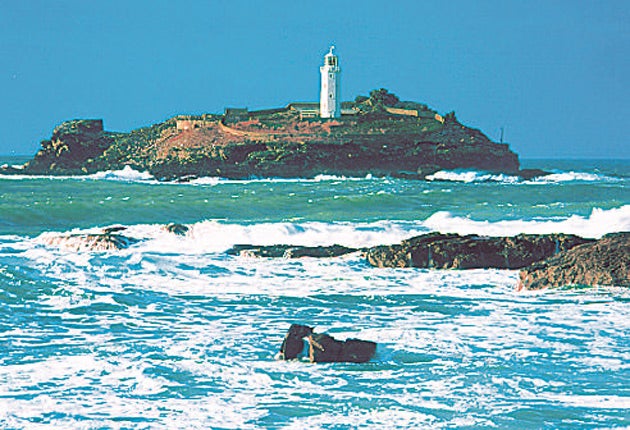Follow the sea to St Ives on this prettiest of trails
Walk of the month: Could this walk along Cornwall's coast be one of the UK's most delightful short hikes, asks Mark Rowe

The longest day draws near, and you can almost hear the rustle of hemp satchels and footwear gathering apace, heading for Stonehenge, Avebury and Britain's other stone circles. If you prefer solitude for your summer solstice, then you'll find it in an unlikely place – just around the corner from one of the country's busiest holiday resorts.
The half-light was distinctly more half than light as I set off for St Ives from the village of Lelant at 5am. The air was chill and still, and in my imagination I could hear the ghostly groans and creaks of the skeletons unearthed in the late 19th century in these sand hills by men digging the railway branch line from St Erth to St Ives that accompanies you for most of this walk
The first section follows a classic, dozy country lane, framed by fine houses on one side, and the magical intertidal saltings and mudflats of the Hayle estuary on the other. When the sea retreats, releasing its grip on the Hayle River at low tide, the enchanting ponds of the saltings – straight from C S Lewis's The Magician's Nephew – become a haven for wildlife. Oystercatchers, egrets, shelduck and, if you're really lucky, purple sandpipers, are all at work, rootling for worms and crustaceans.
But as dawn approached, it was the wild flowers of the pink campion that captivated me: the first rays of sun appeared directly over Godrevy Island, but just before they did, I noticed these flowers were already standing to attention, ready to bathe in the light of day. Blackbirds began to clear their throats, and the first swallow of the day – or was it a bat? – flitted past.
I could have stayed all morning – and waited for the delightful tea house by the station to open – but instead I pressed on to the village church, St Uny. It dates to the 15th century and stands gloriously – as many Cornish churches do – on a superb headland, gazing down the estuary. The tombstones look as ancient as the church, and the churchyard is part of a wider network of church wildlife projects: walk around a church and you'll find that the north, south, east and west graveyards, influenced by varying levels of exposure to the sun and wind directions, can contain different flowers, lichens and insects.
The coast path shimmers through the golf course in what looks like a trench from the First World War and leads to the first superb views of St Ives Bay, the north Atlantic and, there in the distance, Godrevy, Virginia Woolf's inspiration for To the Lighthouse. I soon realised this walk was a contender for one of the most delightful short hikes in the UK: to the left was the branch line – the first two-carriage service ambled past at 6.15am – and to the right were Porthkidney Sands, rolling dunes that drop to an enticing beach, stretched pancake thin in a crescent to Godrevy Point. Just before Carbis Bay, the path soars and sweeps through woodland, laden with wild garlic, and the bluebells were hanging on – you may catch them still. Then it drops past a lonely artist's studio to come to Carbis Bay.
The walk from here to St Ives is as easy as they come, but there's no need to hurry. Pausing at a succession of vantage points I watched as St Ives, its stolid, granite harbour almost always visible, came to life.
Inshore crabbing boats were chugging back and forth, the night-time catch of crabs and lobsters being hauled aboard, while herring gulls hovered overhead.
With only four miles on the clock, it seemed extravagant to dine on a bacon roll from the Porthminster Beach Café. But sitting alone on the sand, with only a patient great black-backed gull (these genuinely scary birds brook no nonsense), and the sea shimmering with the translucence of blue butterflies, it was extravagance I could live with.
The route
Alighting at the train station, head through the park-and-ride car park, bearing left.
Turn right immediately behind the ticket kiosk and then bear right again along the paved lane, following the acorn sign, which signifies the South West Coast Path.
Follow the lane for a mile until it rises slightly uphill to meet a road joining from the left-hand side.
Turn right, pass through the churchyard, following the lane through the golf course and dipping beneath the train line.
Immediately turn left along a sandy track and follow this track towards Carbis Bay.
Just before the headland of Carrack Gladden, take the lower path, which is signposted for the artist's studio. Keep to the higher path above Carbis Bay, turning right to join the road down to the cove.
Follow the coast path to the right of the Carbis Bay Hotel. Climb and cross the railway bridge and follow the paved path to St Ives, crossing another rail bridge just before you reach Porthminster Beach.
Distance: 4 miles
Time: Two to three hours
OS Map: Explorer 102, Land's End, Penzance and St Ives.
How to get there
The walk is best done by taking the train to Lelant Saltings and walking west to St Ives. Lelant is on the St-Ives-St Erth branch line. St Erth is on the mainline from the east to Penzance. Branch train times from firstgreatwestern.com and mainline times to St Erth from crosscountrytrains.co.uk.
Where to stay
Blue Hayes (01736 797129; bluehayes.co.uk), a private hotel overlooking St Ives Bay, offers B&B from £75 per person.
Refreshments
Old Station Café, Lelant. Porthminster Beach Café, St Ives.
Join our commenting forum
Join thought-provoking conversations, follow other Independent readers and see their replies
Comments